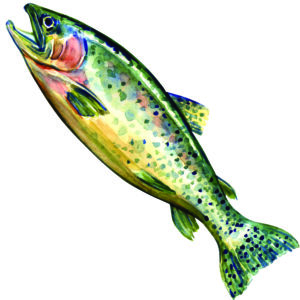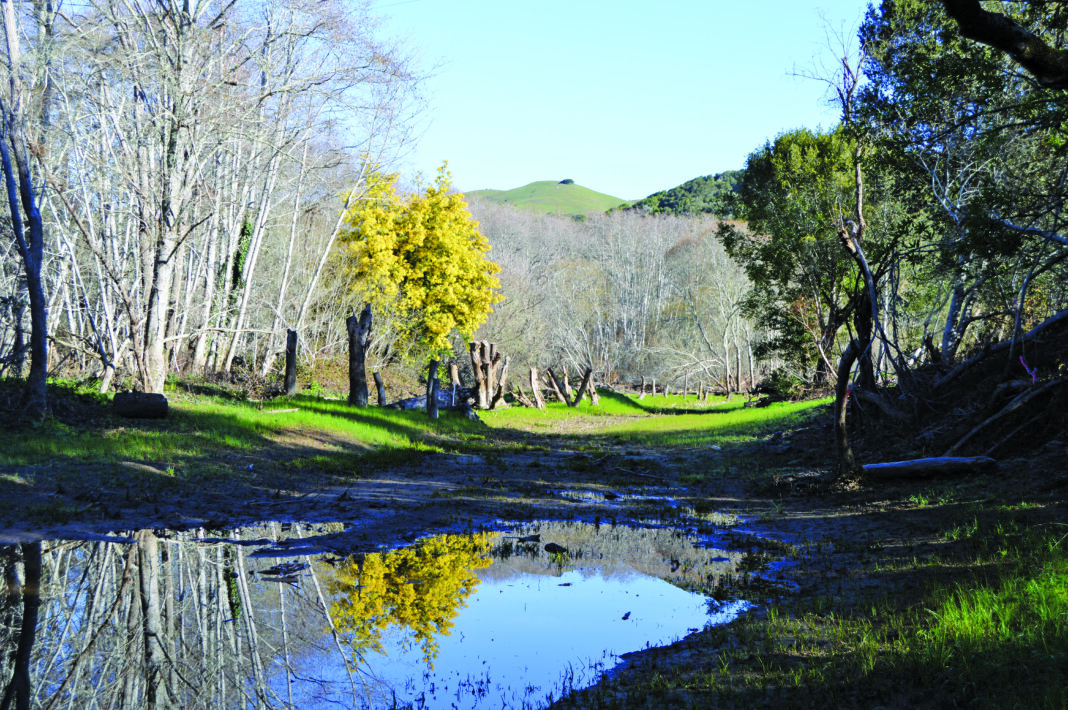State Senator Mike McGuire convened the 45th annual Zeke Grader Fisheries Forum last week in Sacramento, bringing together a dozen-odd anglers and experts for an afternoon of testimony about the state of California’s aquatic life. Grader was a legendary commercial fisherman in the state, who died a few years ago.
As McGuire noted, the fisheries meeting this year had special significance, occurring as it did against the backdrop of a reinvigorated offshore gas- and oil-drilling push from Washington, which pretty much nobody in California is supporting.
The meetings occurred against an additional backdrop which has seen sardine populations collapsing across the state and where, in Marin County, state health officials moved to shut down the coastal shell-fishery there two weeks ago because of high levels of a potentially fatal poison found in mussels and oysters at Point Reyes National Seashore.
Warmer-than-usual ocean temperatures are the suspected culprit, an increasingly common theme in state waters that have only recently come through a devastating and demoralizing outbreak of domoic acid poisoning in Dungeness crabs. In short, the poisoning occurs via algae blooms that occur in warm water.
“Climate change is no longer a theory,” says McGuire. “It’s here in California’s environment and [the state] is paying the price,” regardless of climate denialism in Washington and a ruthless push to drill, baby, drill.
There’s lots of bad news and some good news coming out of the fisheries meeting, which featured panelists from government, the commercial fishing industry, the environmental community and recreational anglers.
The bad news is that the waters are warming, the drought is making a comeback, President Trump would build oil rigs in the Gulf of the Farallones if he could get away with it—and none of that is good news for fish, especially spawning fish. The further bad news is that despite some positive signs of a coho comeback in local creeks, the state’s salmon fishery is on the ropes.
McGuire noted that as much as 80 percent of the state’s salmon population is worse off than it was a decade ago. Within the century it is expected that half to all California salmon may be extinct without radical and ongoing efforts to save them.
Charlton Bonham, the director of the California Department of Fish and Wildlife (CDFW), gave a fairly grim presentation that zeroed in on the good news-bad news dynamic, with an unfortunate emphasis on the bad: In the positive column, he noted that the forecast for the fall salmon run in the Sacramento River is almost identical to last year, when some 230,000 adults returned to their spawning grounds.
At the same time, the winter chinook run in the Central Valley was a total bust last year, with some 1,500 fish returning to spawn. They’ve been eliminated from and cannot access any of their historical habitat. “Frankly if we had another year of drought, that fish could be gone,” reported Dr. Robert Lusardi, a research ecologist and salmon expert with UC Davis.
The bad news is that the sardine fishery continues its precipitous decline and will be shut down to commercial fishing for the fourth consecutive year. Bonham says that the sardine biomass of 52 metric tons is below catch limits that were historically set at 100 metric tons.
The Grader forum was held as the Pacific Fishery Management Council was also meeting last week, and this week, in Rohnert Park to set management measures for 2019.
Meanwhile, the National Marine Fisheries Service has also reported recently that since 2006, the California sardine fishery has collapsed by 97 percent. Red abalone is closed because of a fisheries collapse in that lucrative market (Bonham cited the loss of kelp forests and changing ocean conditions as the main drivers). Sea urchins are similarly on the ropes, and Bonham told attendees that the Dungeness crab, salmon, sea urchin and sardine fisheries should all qualify as federal disasters.
Because of domoic acid poisoning, the Dungeness fishery was declared a disaster two years ago, which ultimately led to a $30 million kick-in from Congress to help affected fishermen and the industry.
New salmon, sardine and sea urchin disasters, Bonham says, “await the feds—await Congressional funding.”
The good news is that better habitat awaits coho salmon and steelhead trout in two North Bay creeks that have been the recipient of funds designed to help re-establish floodplains.
Those funds continue to be accessible, says Bonham, who reported that thanks to grants made available under the Proposition 1 water bond, the state had doled out $115 million for 112 different fish-enhancing projects, with just shy of half of the effort going to the benefit of salmon and steelhead.
He says CDFW is doing a spring solicitation for “shovel-ready projects” to help the fish, with a special emphasis on Central Valley fish projects and a focus on salmon waterways that may have been affected by the 2017 wildfires. He cited the Mark West Creek in Santa Rosa, which spills into the Russian River, as an area where the agency would focus on a nexus point of wildfire and fish recovery.
“The key to restoring steelhead trout and salmon is promoting the habitats,” Lusardi said.
He identified numerous areas where California could work to ensure that the state’s salmon population isn’t totally wiped out within 50 years, as he emphasized, for example, a critical need to re-establish floodplains along the Yolo River.
Similar projects in the North Bay have appeared to bear some good results.
In Sonoma County, the Gold Ridge Resource Conservation District worked with the Thomas Creek Ranch Homeowners Association to restore lower Green Valley and Thomas creeks in Forestville as a winter coho salmon wetland habitat several years ago. Only recently, in the aftermath of the last drought, have those efforts borne fruit.
In Marin County, meanwhile, officials are cheering the performance of newly restored floodplains on Lagunitas Creek, one of the most productive coho salmon creeks in the state.
The Forestville project began in 2014 when the conservation district constructed a 220-foot side channel and wetland along Green Valley Creek, and realigned a section of Thomas Creek to create a deep backwater “alcove” for fish. The drought made it difficult to tell if the construction was making a difference in the coho salmon population, due to the sluggish winter flow.
Creek to create a deep backwater “alcove” for fish. The drought made it difficult to tell if the construction was making a difference in the coho salmon population, due to the sluggish winter flow.
Called an “off-channel winter refuge habitat enhancement for salmonids,” the project is aimed at giving young salmon refuge from high flows in wintertime that otherwise could sweep them away. Green Valley Creek used to provide habitat, but residential developments along the creek, plus a demand for the water by farmers, have greatly reduced the coho salmon and aquatic insects that lived and bred in the calm waters of the channels.
“Our whole community is thrilled with the project and glad that we were able to provide the space to make it happen,” says association member Alan Siegel.
Siegel, an environmentalist since his high school days, came up with the idea to help restore the creek’s natural habitat when he took his daughter, Katie, to a salmon fishery about 10 years ago. He convinced his fellow association members to dedicate land along the creek to the conservation district.
“It took many, many years to figure out what kind of project [they] wanted to do,” he says, “and then once that was nailed down, it took many more years to get all the funding. Grants and funding for the $550,000 projects came from the National Oceanic and Atmospheric Administration’s Fisheries Restoration Grant Program, the California Department of Fish and Wildlife, the California Coastal Conservancy and the Sonoma County Water Agency.
With salmon thriving in the creeks, Siegel says the district is now looking to collaborate with more landowners on similar projects. “One of the things they really want to show is that they can work together with private landowners in a cooperative way that benefits the fishery and the landowner,” he says.
Meanwhile in Marin County, coho salmon and steelhead trout, a federally threatened species, are returning to Lagunitas Creek thanks to a similar floodplain-restoration project undertaken by the Marin Municipal Water District (MMWD).
Last fall, water district fisheries program manager Gregory Andrew was hoping for a season of average rainfall. Too much rain, he said, could scour away sediment and wash out newly created wooden structures designed to help re-animate legacy floodplains on Lagunitas Creek.
Too little rain, on the other hand, wouldn’t see enough water in the creek to spill over into the newly created floodplains, which are designed to attract spawning coho salmon and steelhead.
With the key drought arbiter, the Sierra snowpack, coming in at a dismal 70 percent below normal this year, the drought is back. But Andrew says the restoration project performed remarkably well this winter as he notes that a big rainstorm that blew through on January 8-9 this year raised the flows in the Lagunitas Creek to levels sufficient to inundate the floodplain channel. The coho apparently took notice.
Fish are monitored at every life stage by surveyors, says Andrew, who cautions that there is a lot of variability from year to year, “and also lots of variability from one life phase to another.” For example, he says, this year the adult coho spawning numbers are below average. Yet last year fish surveyors marveled at juvenile smolts headed to the sea for the first time, “in numbers we never saw before,” he says.
More good news is that the fish stocks are generally headed in the right direction after the low point of 2008-09. “With the smolt numbers,” Andrew says, “there is some indication that there is increased winter survival and that may be related to the habitat enhancement work that we’ve already done.”
Project monitors have utilized time-lapse video of the creek this winter to monitor the restoration and the weather’s impact on the work done so far. During the January storm, he says, water flows on the creek got close to 1,000 cubic feet of water per second (the summertime standard is about 8 lazy cubic feet per second). Planners had hoped that those channels would become engaged by the flow when the water was flowing at between 100 and 300 cubic feet per second. The fact that the channels were “engaged” at the low end of their expectation was an encouraging sign to Andrew. The Phase I part of the project at Platform Ridge Road and the Sir Francis Drake Highway, he says, “behaved beautifully and the floodplain channel engaged at 100 cubic feet per second.”
This time of year, the typical flow in the Lagunitas runs up to 2,000 cubic feet per second, Andrew says. The drought-busting winter of 2016-17 saw days where the creek was ripping along at 5,000 CFPS, which could have been perilous to the work undertaken this past summer.
“I’m glad that our structures weren’t newly constructed last fall,” Andrew says, invoking the year the drought broke.
The successful rollout of this $1.2 million, two-year project occurs in a year which sounds like a pretty good one at least for North Bay salmon fisheries.
Andrew says the year has been “unusual for salmon,” given that, for example, a pink salmon showed up in the Lagunitas “and we have not seen them for many years.” He says there was a good run of Chinook and chum salmon on the creek, too. “Over the years we’ve seen chinook come and go and have seen a relatively small number of chum salmon. This year, we had them all in early. Then the coho came in, and they tend to do their thing in January and February.”
“Their thing” is to spawn. The coho are all gone now, Andrew says, and now it’s the steelhead trout’s time to breed—“they’re the only species that’s in there now.”
The steelhead numbers, too, are “looking pretty good,” Andrew reports. He’d gotten a report recently about a big school of the fish hanging out under a bridge in Pt. Reyes Station, near where the Lagunitas spills out into Tomales Bay, and ready to head upstream into their new floodplain.
Back in Sacramento, the discussion throughout the afternoon last week continued to turn back to big-ticket items on the federal agenda, and their potential impacts on California.
Dave Bitts, president of the Pacific Coast Federation of Fishermen’s Associations, told McGuire and the panel that offshore drilling “would be disastrous for salmon fisheries,” and anyone who makes a living as a commercial fisherman. He was similarly dismissive of Gov. Jerry Brown’s “twin tunnel” plan for the Sacramento River Delta.
“We believe the twin tunnels would be catastrophic for all fish and wildlife that uses the estuary. You can’t restore it by diverting the water.”
Yet Brown was also given high marks by John Laird, secretary of the state Natural Resources Agency, when he told McGuire that the governor wouldn’t let the Trump administration rig the California economy with new offshore drilling permits. “[Interior Secretary Ryan] Zinke decided to come to the capital on Oceans Day,” says Laird. “The governor pressed him in person, he was relentless in his interpersonal push on this, so just trust us, we are working on it.”
Alex T. Randolph contributed reporting to this story.










